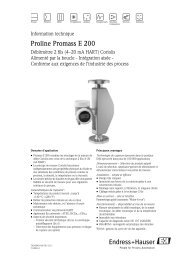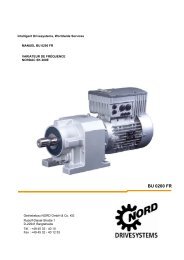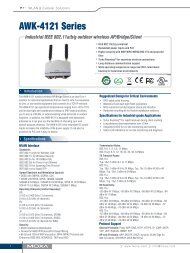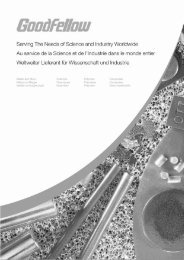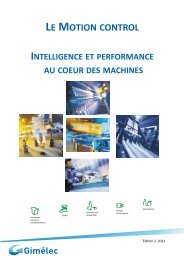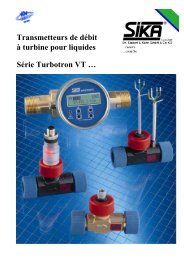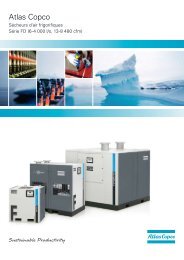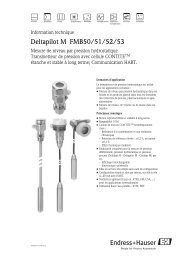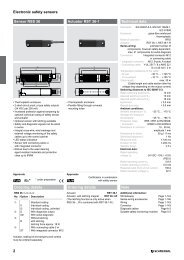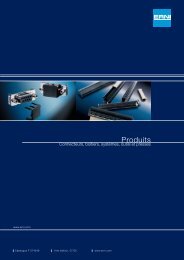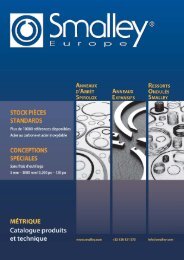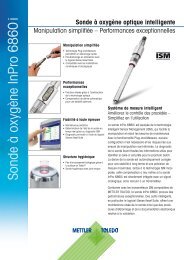Flexible Heaters Design Guide - BiS Sistem
Flexible Heaters Design Guide - BiS Sistem
Flexible Heaters Design Guide - BiS Sistem
Create successful ePaper yourself
Turn your PDF publications into a flip-book with our unique Google optimized e-Paper software.
Examples of Thermal Systems<br />
Description of<br />
Thermal System<br />
Wattage<br />
requirements<br />
Electrical<br />
parameters<br />
Heater selection<br />
Warm a test instrument in an avionics<br />
system from as cold as -45°C to 70°C<br />
within two minutes with ±2°C accuracy.<br />
The instrument is a cylinder 1.25"<br />
(32 mm) diameter and 3.5" (89 mm)<br />
tall, providing a heating area of 3.9 ×<br />
3.5" (100 × 89 mm). The available voltage<br />
on the aircraft is 28 VDC.<br />
From Thermal Calc*, we need 60 watts<br />
warmup power and 25 watts maintenance<br />
power.<br />
Maintain 96 sample vials, each containing<br />
10 ml of human blood, at<br />
37°C. The vials are positioned in<br />
drilled blind holes in an aluminum<br />
block measuring 4.0" × 6.0" × 1.5"<br />
(102 x 152 x 38 mm) with a total mass<br />
of 500 g. The sample temperature<br />
must never exceed 40°C at 24 VDC.<br />
From Thermal Calc*, we need 60 watts<br />
for warmup and maintenance.<br />
A 300 mm silicon wafer placed on a<br />
325 mm diameter aluminum chuck<br />
must be heated from 40°C to 220°C<br />
during processing. Input voltage is<br />
208 VAC.<br />
From Thermal Calc*, we need 800 watts<br />
to reach the required temperature<br />
within the time limit.<br />
R = E²/W = 28²/60 = 13.1 Ω R = E²/W = 24²/60 = 9.6 Ω R = E²/W = 208²/800 = 54.1 Ω<br />
Commercial and military avionics systems<br />
typically specify Polyimide insulated<br />
heaters. Model HK5482R12.1L12A is<br />
selected.<br />
Specifying polyimide because it is<br />
resistant to most chemicals and does<br />
not outgas, the best choice is<br />
HK5491R9.4L12B<br />
The required temperature exceeds the<br />
limit for polyimide heaters, and the vacuum<br />
process does not allow silicone<br />
rubber. An All-Polyimide heater, factory<br />
mounted to the chuck, is required.<br />
Actual wattage Wattage is 28²/12.1 = 65 W Wattage is 24²/9.4 = 61 W Wattage is 208²/54.1= 800 W<br />
Watt density Watt density = W/effective area =<br />
65/9.8 in² = 6.6 W/in² (1.0 W/cm²)<br />
Installation For this cylindrical shape heat sink, a<br />
BM3 Shrink Band is selected.<br />
Leadwire current AWG 26 current rating is 5.0 A. Actual<br />
current is:<br />
I = 28/12.1 = 2.3 A (OK).<br />
Control The CT325 controller will be used to<br />
control the heater.<br />
Sensor<br />
Custom options<br />
An S665 Thermal Tab RTD provides easy<br />
installation in the prototype test system.<br />
Experiments confirm the power<br />
requirements, but also show that the<br />
sensor measures only one point rather<br />
than the average temperature of the<br />
cylinder. In the final custom design an<br />
integrated Thermal-Ribbon strip sensor<br />
wraps around the circumference of the<br />
cylinder to measure the average temperature.<br />
Watt density = W/effective area =<br />
61/21.54 in² = 2.8 W/in² (0.4 W/cm²)<br />
Any type of heater mounting will handle<br />
the watt density. We recommend<br />
acrylic PSA for fast availability of prototypes.<br />
AWG 24 leadwire current rating is 7.5 A.<br />
Actual current is:<br />
I = 24/9.4 = 2.6 A (OK).<br />
A custom control circuit integrated into<br />
the system electronics will control the<br />
heater. The controller is designed for a<br />
1000 Ω platinum RTD element input.<br />
A 1000 Ω platinum Thermal-Tab RTD<br />
sensor is used. The customer tests the<br />
sensor in several positions around the<br />
aluminum block to determine the optimum<br />
location.<br />
Testing showed that edge losses<br />
required 20% higher watt density<br />
around the periphery of the heater to<br />
equalize temperature within the block.<br />
A custom design with profiled power<br />
output, integrated sensor, and 40°C<br />
thermal fuse provides a complete thermal<br />
system in one package.<br />
Watt density = W/effective area =<br />
800/109.9 in² = 7.3 W/in² (1.1 W/cm²)<br />
Factory lamination of AP heaters provides<br />
optimum heat transfer and allows<br />
operating temperatures higher than<br />
other adhesives.<br />
AWG 20 leadwire current rating is 13.5<br />
A. Actual current is:<br />
I = 208/54.1 = 3.8 A (OK).<br />
All electrical and motion control of the<br />
wafer processing system is centrally<br />
controlled by a computer. Thermal control<br />
is integrated into the system.<br />
An S247 thin film RTD element with<br />
high-temperature extension leads will<br />
be cemented into a hole in the platen.<br />
The leads exit is located at the center of<br />
the heater to fit with the design<br />
requirements of the machine.<br />
*Thermal Calc is an on-line tool available at www.minco.com/e2e to assist in estimating heater wattage requirements from known<br />
parameters.<br />
Introduction<br />
<strong>Design</strong><br />
<strong>Guide</strong><br />
Polyimide<br />
<strong>Heaters</strong><br />
Silicone<br />
Rubber<br />
<strong>Heaters</strong> (foil)<br />
Standard<br />
Polyimide<br />
& Rubber<br />
Rubber<br />
<strong>Heaters</strong><br />
(wire-wound)<br />
Mica <strong>Heaters</strong><br />
Thermal-Clear<br />
<strong>Heaters</strong><br />
All-Polyimide<br />
<strong>Heaters</strong><br />
Sensors,<br />
Controllers &<br />
Accessories<br />
Reference<br />
| <strong>Flexible</strong> <strong>Heaters</strong> <strong>Design</strong> <strong>Guide</strong> | www.minco.com<br />
15





